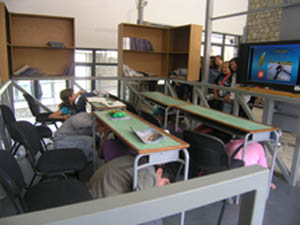

An original educational programme was been designed by the Lesvos Petrified Forest Geopark and runs in the Natural History Museum in Sigri. The programme has been enthusiastically welcomed by the schools of Lesvos, but also of other Greek areas that visit the island to participate in it. The theme of the programme is a burning issue in Greece and many other countries located along tectonic plate boundaries. Specifically, the programme concerns the natural phenomenon of the earthquake and seismic hazard.
The 2-hour programme, addressed to basic and secondary educational level, includes a presentation on the causes of earthquakes, the ways the seismic waves travel through the Earth and the catastrophic effects they might have. Subsequently, the children visit the Museum’s exhibition hall where they can visualise the movements of the Earth’s crust and their link with the generation of earthquakes through interactive models. A real seismometer records the waves they produce on the ground while walking, while screens show the recordings of the seismographs in Sigri and the University of Thessaloniki in real time. A poster exhibition gives further information on the connection between mythological characters and natural phenomena, historical earthquakes in the islands on NE Aegean, large faults in these islands linked with the most recent tectonic activity in the Aegean area and other catastrophic natural phenomena linked with the earthquakes. The children have the great opportunity to see a real fault in the back-yard of the museum and understand how the rocks deform, fracture and move along the fault plane. The highlight of the programme, without any doubt, is the seismic table installation of the Museum. The installation, turned into a school-class, can simulate the seismic movement of some of the most destructive earthquakes of the recent years. Children can sit in their desks and feel the tremors the people of Cobe, Japan, felt on the 17th January 1995, or of Gujarat, India, on the 26th of January 2001. This activity aims to the familiarisation of the children with the right behaviour during and right after an earthquake, since they can practise what they learn during the programme in a perfectly safe environment.
The new educational programme of the Lesvos Petrified Forest Geopark has until now a huge success, since more than 900 children have already participated and about 500 more have already booked. The great value of this programme in an area with very intense seismic activity such as the NE Aegean is evident. Greece, being at the front of the Eurasian tectonic plate which collides with the African one, is the most seismic country in Europe and earthquakes are very usual and, in some areas, even every-day events. The programme targets to the familiarisation of children with earthquakes and natural phenomena that can follow them, as knowledge is the most successful weapon against an earthquake’s catastrophic effects.